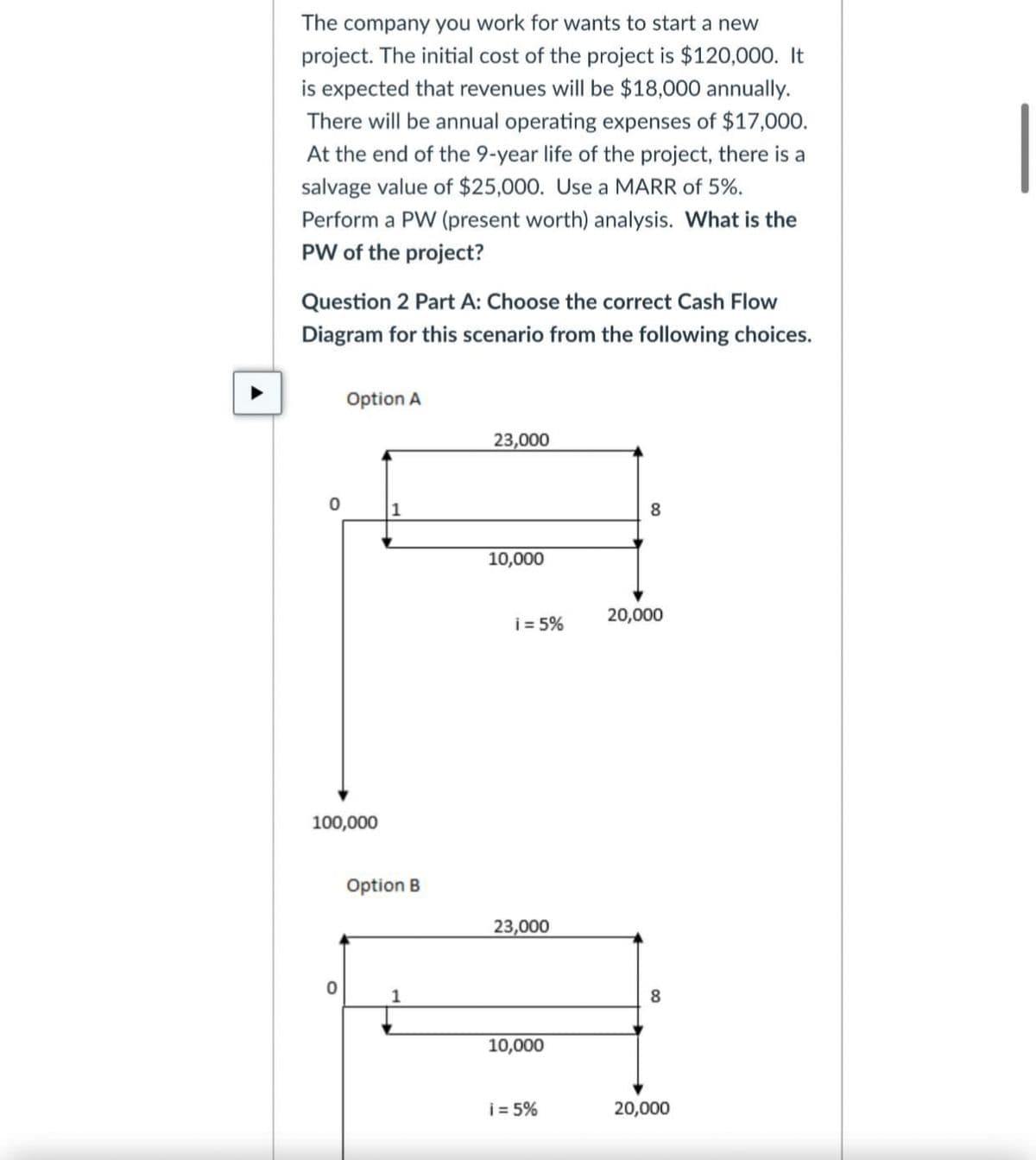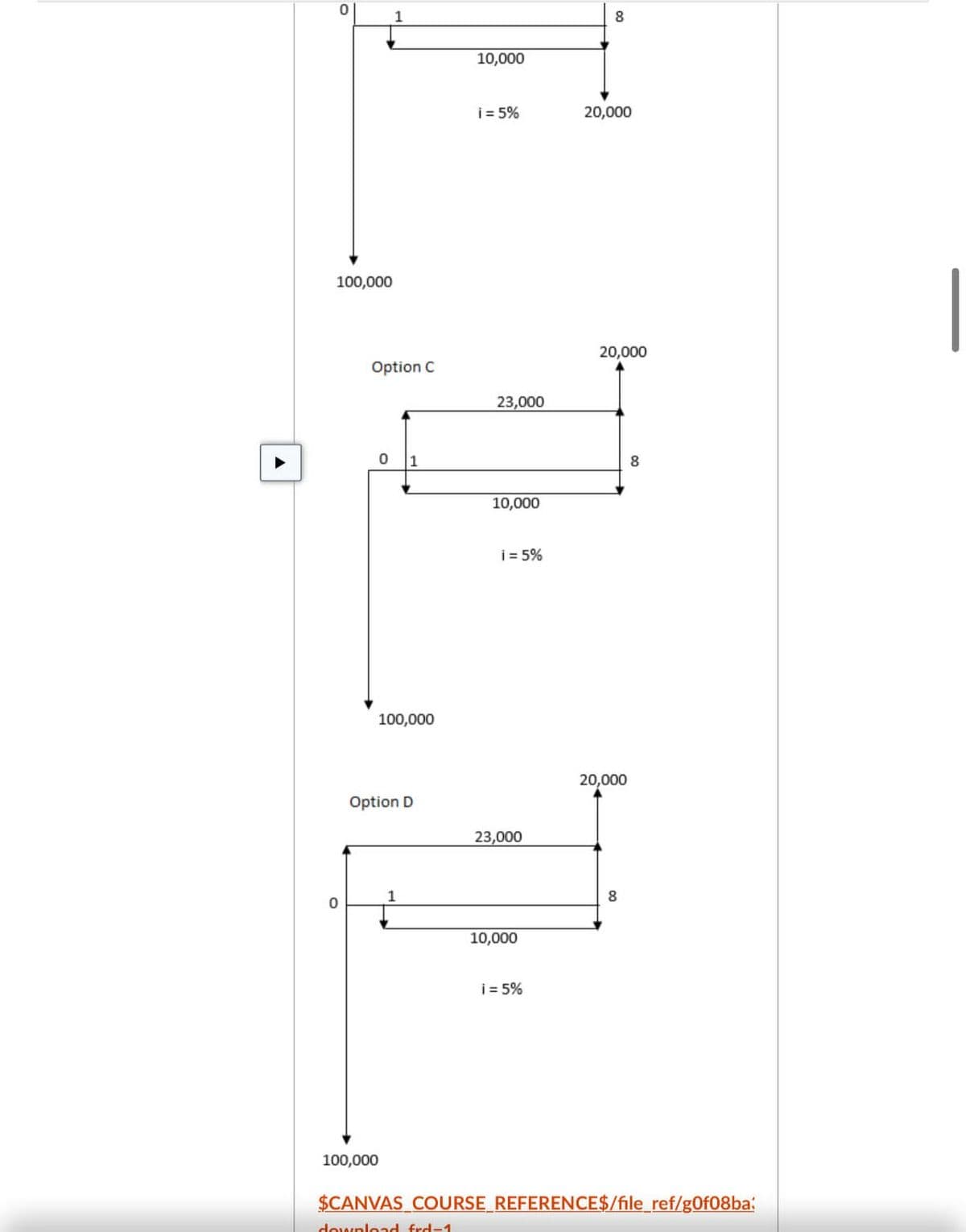project. The initial cost of the project is $120,000. It is expected that revenues will be $18,000 annually. There will be annual operating expenses of $17,000. At the end of the 9-year life of the project, there is a salvage value of $25,000. Use a MARR of 5%. Perform a PW (present worth) analysis. What is the PW of the project? Question 2 Part A: Choose the correct Cash Flow Diagram for this scenario from the following choices.
project. The initial cost of the project is $120,000. It is expected that revenues will be $18,000 annually. There will be annual operating expenses of $17,000. At the end of the 9-year life of the project, there is a salvage value of $25,000. Use a MARR of 5%. Perform a PW (present worth) analysis. What is the PW of the project? Question 2 Part A: Choose the correct Cash Flow Diagram for this scenario from the following choices.
Chapter1: Making Economics Decisions
Section: Chapter Questions
Problem 1QTC
Related questions
Question

Transcribed Image Text:The company you work for wants to start a new
project. The initial cost of the project is $120,000. It
is expected that revenues will be $18,000 annually.
There will be annual operating expenses of $17,000.
At the end of the 9-year life of the project, there is a
salvage value of $25,000. Use a MARR of 5%.
Perform a PW (present worth) analysis. What is the
PW of the project?
Question 2 Part A: Choose the correct Cash Flow
Diagram for this scenario from the following choices.
Option A
23,000
1
8
10,000
i = 5%
20,000
100,000
Option B
23,000
8.
10,000
i = 5%
20,000

Transcribed Image Text:1
8
10,000
i = 5%
20,000
100,000
20,000
Option C
23,000
1
8
10,000
i = 5%
100,000
20,000
Option D
23,000
1
8
10,000
i = 5%
100,000
$CANVAS COURSE_REFERENCE$/file_ref/g0f08ba:
download frd=1
Expert Solution
This question has been solved!
Explore an expertly crafted, step-by-step solution for a thorough understanding of key concepts.
This is a popular solution!
Trending now
This is a popular solution!
Step by step
Solved in 3 steps

Knowledge Booster
Learn more about
Need a deep-dive on the concept behind this application? Look no further. Learn more about this topic, economics and related others by exploring similar questions and additional content below.Recommended textbooks for you


Principles of Economics (12th Edition)
Economics
ISBN:
9780134078779
Author:
Karl E. Case, Ray C. Fair, Sharon E. Oster
Publisher:
PEARSON

Engineering Economy (17th Edition)
Economics
ISBN:
9780134870069
Author:
William G. Sullivan, Elin M. Wicks, C. Patrick Koelling
Publisher:
PEARSON


Principles of Economics (12th Edition)
Economics
ISBN:
9780134078779
Author:
Karl E. Case, Ray C. Fair, Sharon E. Oster
Publisher:
PEARSON

Engineering Economy (17th Edition)
Economics
ISBN:
9780134870069
Author:
William G. Sullivan, Elin M. Wicks, C. Patrick Koelling
Publisher:
PEARSON

Principles of Economics (MindTap Course List)
Economics
ISBN:
9781305585126
Author:
N. Gregory Mankiw
Publisher:
Cengage Learning

Managerial Economics: A Problem Solving Approach
Economics
ISBN:
9781337106665
Author:
Luke M. Froeb, Brian T. McCann, Michael R. Ward, Mike Shor
Publisher:
Cengage Learning

Managerial Economics & Business Strategy (Mcgraw-…
Economics
ISBN:
9781259290619
Author:
Michael Baye, Jeff Prince
Publisher:
McGraw-Hill Education